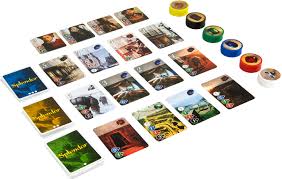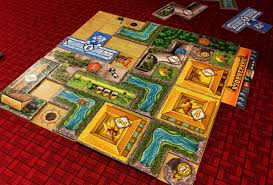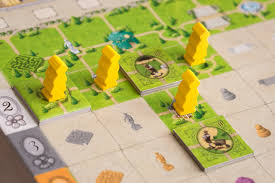Game Mechanics: Incentivizing players and giving them a starting direction
Last week’s article focused on ways to keep players engaged in your game. This week we’ll be discussing game mechanics that help incentivize players, as well as ways to point them in the right direction from the start of the game.
Quite often when you’re designing a game you find that players don’t do the types of things you want them to. Instead of collecting and trading resources, one player might be amassing a fortune in gold, while other players are just exploring the island, for example.
So, how do we as game designers ensure that players are taking the actions that we intended them to take and guide them towards their ultimate goal?
Using Game Mechanics for Incentivizing Players to Do What You Want
In order for players to take on certain strategies, go after particular items, or travel in a specific direction, you have to give them a reason to do so.
This can be accomplished in one of many ways. Often, it comes down to rewards and punishment. You want to reward players for going down the correct path and/or give consequences when they don’t.
It’s all part of a feedback loop. The right actions lead to good things, and the wrong actions put you further behind.
Let’s look at some examples of games that do this well.
I know I’ve talked about Splendor a couple of times already in this series (on making players feel smart and keeping players engaged) but it’s such a simple and elegant game that does things so well.

The intention in Splendor is for you as the player to collect enough gem tokens to start buying cards and then chain them together to buy better cards and start collecting more valuable cards with point values, as well as the Noble tiles.
If you simply continue to collect tokens, it will be very hard, if not impossible, to gather enough to purchase point cards. At the same time, if you only collect cards from the first row that don’t contain any points, you may end up with a lot of cards but it will be hard to win, as you need to gain 15 points to achieve victory. You’ll watch as other players trade up their tokens and use their cards, leaving you in the dust.
Splendor also makes it very clear that your goal is to get 15 points and shows you how to get there.
Barenpark is another good example. It makes use of polyomino tiles that you must place in your park. Whenever you cover a symbol with your piece, you will gain the associated structure or an additional park expansion board.

When you complete each of the 4 boards in your park, you will get to place a bear pit. The first bear pit is worth the most points and each one after this is worth a little less, so you’re incentivized to complete each of your 4 boards quickly to gain more points. However, you must figure out exactly how you’ll go about doing this through the pieces (structures) you gather and where you place them.
As you can see from these examples, including game mechanics where players gain something from taking actions you would like them to do, makes for strong incentives.
Give Your Players a Clear Direction
While you want to give your players interesting choices to make throughout your game, you also want to ensure that these choices matter and the players can make a well-informed decision.
If you start them off blindly in a game with no direction at all, many players will struggle right out of the gate. They won’t even know what to do on their first turn.
I often see this in other prototypes (and sometimes in my own!). Players are given a wealth of options but no clear direction. They may know that they have to have the most points at the end of the game to win but may not have any clue what a good move looks like to earn those points.
There are a few things you can do to help players.
One way to accomplish this is through hidden objective cards. A good example of this is from the game Sanssouci by Michael Keisling (the designer of Azul).

In Sanssouci, you are given 2 goal cards that indicate you will get bonus points at the end of the game for moving pawns down specific paths. Without this direction and additional incentive, players may have difficulty drafting tiles, as they all might otherwise feel like each tile will provide fairly similar outcomes.
Many other games, from Ticket to Ride to Lords of Waterdeep use hidden objective cards as well.
You can also provide your players with direction by using public objectives or goals that any player can accomplish. You can even incentivize them further by having reduced rewards over time, as we see with the bear pits in Barenpark.
Otherwise, try to make it obvious to players what they need to achieve and the possible ways they can accomplish this.
If your game is about fighting monsters, make the core loop of your game clear to players. For example, if you fight a monster you earn gold. You then spend your gold on better weapons to make yourself more powerful and be able to fight bigger and badder monsters, gaining even bigger rewards.
By making the end goal, along with how to accomplish this, very clear, and possibly giving players specific things to accomplish along the way, you’ll be incentivizing them to do what you wish and pointing them in the right direction right from the start.
What game have you played that has really good incentives or starting directions for players to take?
Please share this with me and other readers by leaving a comment.
Next week we’ll be talking about another important topic in game design, how to use game mechanics to create memorable moments.

6 comments
Bill Murphy
One of my favourite games is Dixit. It is clear that you, the active player, are giving a clue about your secretly submitted card. It has to NOT be obvious. This is because if all players vote for your card, you will get NO points. The other players have also submitted cards and are also trying to get votes based on your clue.
If you get no points, all other players get 2 points. Again reiterating that you really want some votes.
If some players vote for your card but not all, you + all the players who voted for you get 3 points. Again, you want to be vague to only allow a few players to get 3 points.
My love for this game comes from the decisions about how vague you want to be. You really only want 1 vote. You and that player get the 3 points, and that is the best for the active player. Trying for this is difficult because you are teetering on the edge of being too vague, hoping for 1 vote. This is a risk, and you may get no points. Your hope of 1 vote was just not clear enough and lost. The game is clear on what your goal is.
Great game.
Joe Slack
Agreed, Bill! Dixit is a good one. Great art, interesting play, and anyone can understand and play this game.
Elijah
Wingspan’s round goals and their bonus points cards does this really well!
Joe Slack
Another great example. Thanks, Elijah!
Christopher Burdiss
This is Something I have struggling with in my own design of Dungeons and Dragons, after I create a cool moment, I have no follow-up, I need to give people something to hold onto, some clear path they need to follow, which will make starting the game much more enjoyable, thank you for the help!
Joe Slack
That’s great, Christopher!